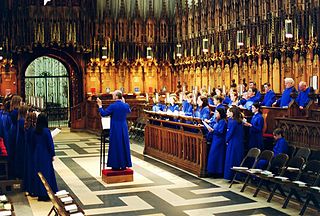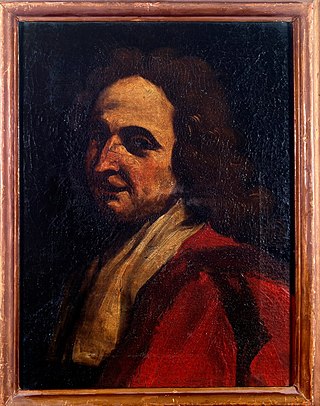Related Research Articles

Opera is a form of Western theatre in which music is a fundamental component and dramatic roles are taken by singers. Such a "work" is typically a collaboration between a composer and a librettist and incorporates a number of the performing arts, such as acting, scenery, costume, and sometimes dance or ballet. The performance is typically given in an opera house, accompanied by an orchestra or smaller musical ensemble, which since the early 19th century has been led by a conductor. Although musical theatre is closely related to opera, the two are considered to be distinct from one another.

Renaissance music is traditionally understood to cover European music of the 15th and 16th centuries, later than the Renaissance era as it is understood in other disciplines. Rather than starting from the early 14th-century ars nova, the Trecento music was treated by musicology as a coda to medieval music and the new era dated from the rise of triadic harmony and the spread of the contenance angloise style from the British Isles to the Burgundian School. A convenient watershed for its end is the adoption of basso continuo at the beginning of the Baroque period.

A choir, also known as a chorale or chorus is a musical ensemble of singers. Choral music, in turn, is the music written specifically for such an ensemble to perform or in other words is the music performed by the ensemble. Choirs may perform music from the classical music repertoire, which spans from the medieval era to the present, or popular music repertoire. Most choirs are led by a conductor, who leads the performances with arm, hand, and facial gestures.
A soprano (Italian pronunciation:[soˈpraːno]) is a type of classical singing voice and has the highest vocal range of all voice types. The soprano's vocal range (using scientific pitch notation) is from approximately middle C (C4) = 261 Hz to "high A" (A5) = 880 Hz in choral music, or to "soprano C" (C6, two octaves above middle C) = 1046 Hz or higher in operatic music. In four-part chorale style harmony, the soprano takes the highest part, which often encompasses the melody. The soprano voice type is generally divided into the coloratura, soubrette, lyric, spinto, and dramatic soprano.
A countertenor (also contra tenor) is a type of classical male singing voice whose vocal range is equivalent to that of the female contralto or mezzo-soprano voice types, generally extending from around G3 to D5 or E5, although a sopranist (a specific kind of countertenor) may match the soprano's range of around C4 to C6. Countertenors often have tenor or baritone chest voices, but sing in falsetto or head voice much more often than they do in their chest voice.
The musical term alto, meaning "high" in Italian, historically refers to the contrapuntal part higher than the tenor and its associated vocal range. In four-part voice leading alto is the second-highest part, sung in choruses by either low women's or high men's voices. In vocal classification these are usually called contralto and male alto or countertenor.
An oratorio is a musical composition with dramatic or narrative text for choir, soloists and orchestra or other ensemble.
Sheet music is a handwritten or printed form of musical notation that uses musical symbols to indicate the pitches, rhythms, or chords of a song or instrumental musical piece. Like its analogs – printed books or pamphlets in English, Arabic, or other languages – the medium of sheet music typically is paper. However, access to musical notation since the 1980s has included the presentation of musical notation on computer screens and the development of scorewriter computer programs that can notate a song or piece electronically, and, in some cases, "play back" the notated music using a synthesizer or virtual instruments.

Singing is the act of creating musical sounds with the voice. A person whose profession is singing is called a singer, artiste ,vocalist and rapping. Singers perform music that can be sung with or without accompaniment by musical instruments. Singing is often done in an ensemble of musicians, such as a choir. Singers may perform as soloists or accompanied by anything from a single instrument up to a symphony orchestra or big band. Many styles of singing exist throughout the world.
A mezzo-soprano (Italian:[ˌmɛddzosoˈpraːno], lit. 'half soprano'), or mezzo ( MET-soh), is a type of classical female singing voice whose vocal range lies between the soprano and the contralto voice types. The mezzo-soprano's vocal range usually extends from the A below middle C to the A two octaves above (i.e. A3–A5 in scientific pitch notation, where middle C = C4; 220–880 Hz). In the lower and upper extremes, some mezzo-sopranos may extend down to the F below middle C (F3, 175 Hz) and as high as "high C" (C6, 1047 Hz). The mezzo-soprano voice type is generally divided into the coloratura, lyric, and dramatic.

The rondo is a musical form that contains a principal theme which alternates with one or more contrasting themes, generally called "episodes", but also occasionally referred to as "digressions" or "couplets". Some possible patterns include: ABACA, ABACAB, ABACBA, or ABACABA.
A male soprano or boy treble is a young male singer with a voice in the soprano range, a range that is often still called the treble voice range no matter how old.
Vocal range is the range of pitches that a human voice can phonate. A common application is within the context of singing, where it is used as a defining characteristic for classifying singing voices into voice types. It is also a topic of study within linguistics, phonetics, and speech-language pathology, particularly in relation to the study of tonal languages and certain types of vocal disorders, although it has little practical application in terms of speech.

Anglican church music is music that is written for Christian worship in Anglican religious services, forming part of the liturgy. It mostly consists of pieces written to be sung by a church choir, which may sing a cappella or accompanied by an organ.

Stefano Landi was an Italian composer and teacher of the early Baroque Roman School. He was an influential early composer of opera, and wrote the earliest opera on a historical subject: Il Sant'Alessio (1632).
A voice type is a classification of the human singing voice into perceivable categories or groups. Particular human singing voices are identified as having certain qualities or characteristics of vocal range, vocal weight, tessitura, vocal timbre, and vocal transition points (passaggio), such as breaks and lifts within the voice. Other considerations are physical characteristics, speech level, scientific testing, and vocal register. A singer's voice type is identified by a process known as voice classification, by which the human voice is evaluated and thereby designated into a particular voice type. The discipline of voice classification developed within European classical music and is not generally applicable to other forms of singing. Voice classification is often used within opera to associate possible roles with potential voices. Several different voice classification systems are available to identify voice types, including the German Fach system and the choral music system among many others; no system is universally applied or accepted.

Vocal pedagogy is the study of the art and science of voice instruction. It is used in the teaching of singing and assists in defining what singing is, how singing works, and how singing technique is accomplished.
There is no authoritative system of voice classification in non-classical music as classical terms are used to describe not merely various vocal ranges, but specific vocal timbres unique to each range. These timbres are produced by classical training techniques with which most popular singers are not intimately familiar, and which even those that are do not universally employ them.
A Boy Was Born, Op. 3, is a choral composition by Benjamin Britten. Subtitled Choral variations for men's, women's and boys' voices, unaccompanied , it was originally composed from 1932 to 1933. It was first performed on 23 February 1934 as a BBC broadcast. Britten revised the work in 1955. The composer set different texts related to Christmas to music as theme and variations, scored for an a cappella choir with boys' voices.
Meane is a vocal music term used by English composers of polyphonic choral music during the English pre-Reformation and Reformation eras. At this time choral music written for the Church of England was often voiced in 5 parts, with MAATB or TrMATB being frequent voicings utilized by William Byrd, Thomas Tallis and their contemporaries. The meane part was typically sung by boys whose voices were not as high as a treble or boy soprano but were not as low as a countertenor. Occasionally the meane line would be sung by a combination of treble and countertenor voices.
References
- ↑ Heather Williams Potter (2005). Perspectives on the American Children's Choir: Comparing the Ideas of Jean Ashworth Bartle, Helen Kemp, Henry Leck, and Doreen Rao. University of North Carolina at Greensboro Press. p. 20.
- ↑ Dennis Shrock (2009). Choral Repertoire. Oxford University Press. p. 771.
- ↑ Peter Le Huray (1967). Music and the Reformation in England 1549-1660. CUP Archive. pp. 121–122. ISBN 9780521219587.
- ↑ "Cross-Sexual Casting in Baroque Opera". The Opera Quarterly . 5: 49. 1987.